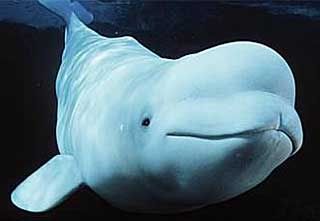Mammals: Beluga Whale

Description
This gregarious whale can be up to 5m long, larger than all but the largest dolphins but smaller than most other toothed whales. Males are generally larger than the female - males can weigh 1.5 tonnes and females about one tonne. Newly-born Beluga are about 1.5m long and weigh 80kg. This whale is unmistakable when adult: it is all white and has a dorsal ridge rather than a fin. The head is also unlike that of any other cetacean - its melon is extremely bulbous and even malleable. The beluga is able to change the shape of its melon by blowing air around its sinuses. Again unlike many whales, the vertebrae in the neck are not fused together, allowing the animal flexibility to turn its head laterally.
The absence of the dorsal fin is reflected in the genus name of the species - apertus is the Latin for "finless". The evolutionary preference for a dorsal ridge in favour of a fin is believed by scientists to be adaption to under-ice conditions, or possibly as a way of preserving heat.
The body of the Beluga is rotund, particularly when well-fed, which tapers smoothly to both the head and tail. The tail fin grows and become increasingly ornately curved as the animal ages. The flippers are broad and short - making them almost square-shaped.
Continue reading here.



4 Comments:
It's a shame some of the majestic creatures are in danger of being extinct.
By Blueyes, at 13:36
Blueyes, at 13:36
yes, indeed. let's hope more people realize this!
By Daldianus, at 08:12
Daldianus, at 08:12
it's a pity.
By bridget, at 05:03
bridget, at 05:03
it really sucks
By Anonymous, at 08:12
Anonymous, at 08:12
Post a Comment
<< Home